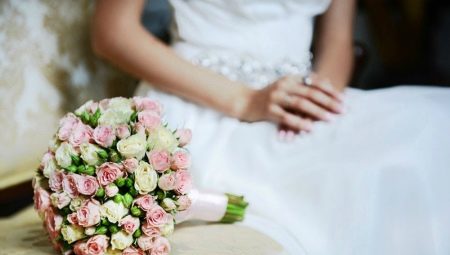For the grace of the petals, the complexity of the shapes and the delicate aroma of a rose, they are called the “flower queens”. They are most often used in wedding compositions, which is why sometimes such bouquets are considered boring and banal. However, this is completely untrue, because a rose can become the basis of the most incredible flower arrangements, looking elegantly and elegantly, sometimes gently and romanticly, sometimes passionately, or strictly.
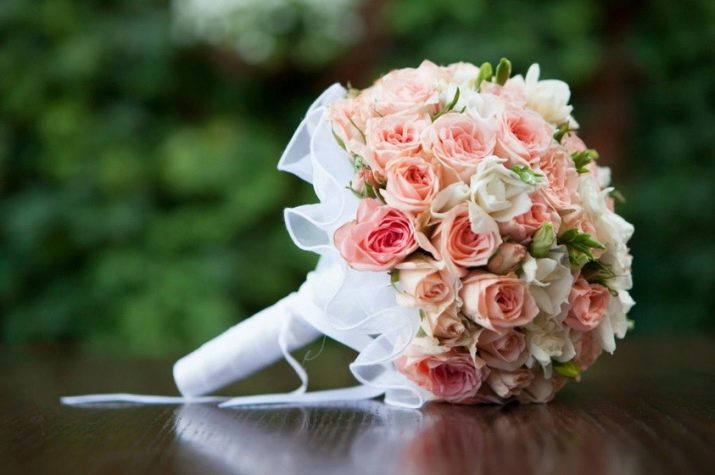
Symbolism of a rose
Rose is one of the most common flowers for a wedding bouquet. Many factors contribute to this, primarily the importance of the rose. In the language of flowers, it symbolizes love, passion, external and internal perfection, eternity, fertility.
In some countries, the meaning of a bouquet of living roses is slightly different. She is most admired in the West. Here you can draw an analogy with the meaning that the lotus in India has. Rose in the West is worshiped as a symbol of purity, innocence, in her ideal and complex structure they see a reflection of the harmony of the universe.
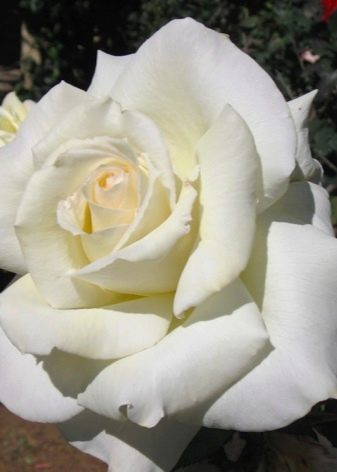
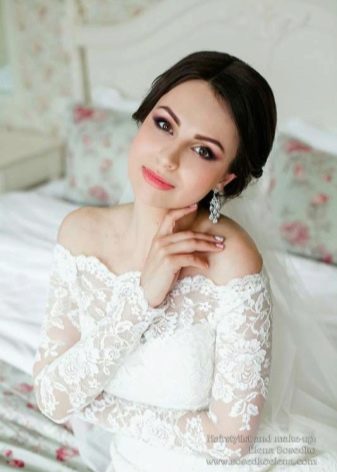
In ancient Rome, roses were considered flowers that save from unnecessary talkativeness, a tendency to gossip and exaggerate, not without reason they decorated the premises of the palaces where negotiations were held.
Nowadays, these flowers at a wedding can be considered a sign of love, happiness. No wonder there is the expression "line the path with roses," which means "make a person’s life happy, pleasant, easy."
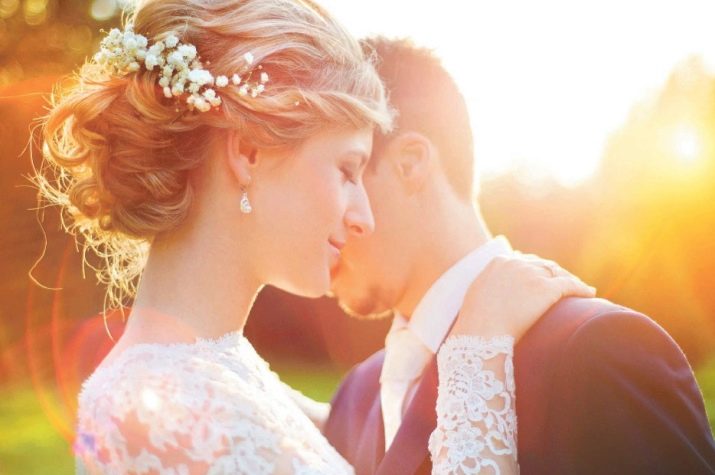
Which brides will suit?
Roses are unique and at the same time universal flowers. They will suit the bride of any complexion, to the wedding along with any style.If we talk about which bride is the “queen of flowers”, it is more correct to consider the features of the finished flower arrangement.
One of the most popular forms of a bouquet of roses for a wedding is considered round. The flowers here are arranged in a spiral, thanks to which it is possible to get a floral circle on a small handle-stem.
Round bouquets are recommended to choose short girls, the style of the dress can be any.
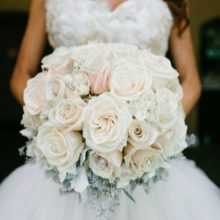
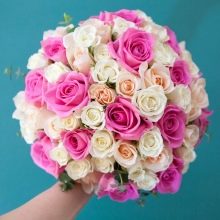
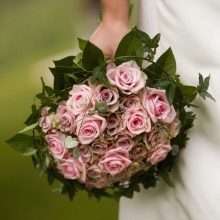
Tall and slender young ladies are advised to choose bouquets on long stems or cascading compositions. Such bouquets are ideal in combination with dresses of a direct style, “fish”, that is, dresses without extra splendor.
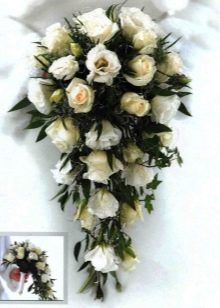
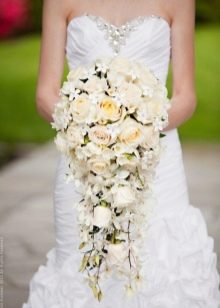
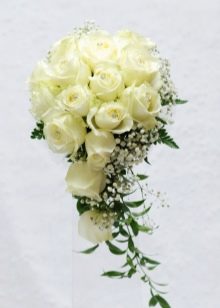
The more complicated and magnificent the dress, the simpler and more concise the bouquet should be. For outfits with trains or a long veil, going down to the floor, cascading compositions are not suitable. A drop-down bouquet and a train will double the attention of guests, hiding the beauty of each other. As a result, neither the train nor the flowers of the original form will receive a portion of admiration due to them.
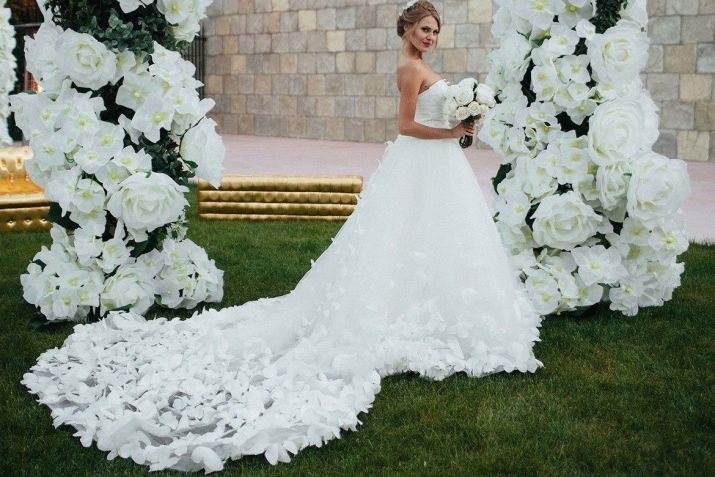
Cascading bouquets, the composition “wand” and flowers on long stems are “contraindicated” also by miniature brides. They will look too big in the hands of short girls, contributing to even more visual decrease in growth.
Lovers of practicality and original solutions can choose bouquets in the form of a bracelet or clutch. The first is worn on the wrist and is good for summer weddings. The second is made in the form of a coupling and looks most organically in winter celebrations. Both options leave hands free, but throwing such a composition (if it is provided for by the celebration scenario) is not very convenient.
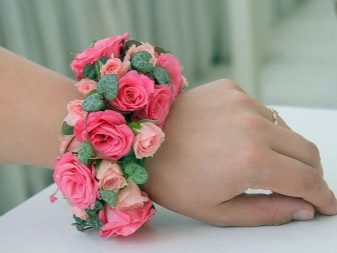
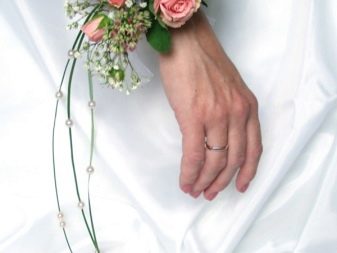
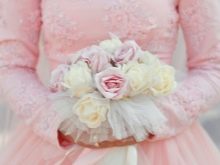


Varieties and shades
Roses have perhaps the largest color palette. One of the most common at the wedding is white flowers. They symbolize the sublime platonic love, purity and purity of the bride. As a rule, modest and tender young ladies prefer compositions from white inflorescences.
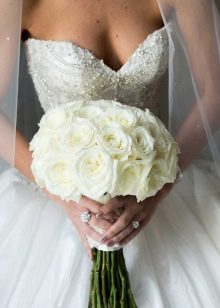
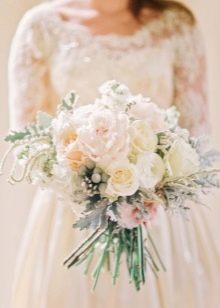
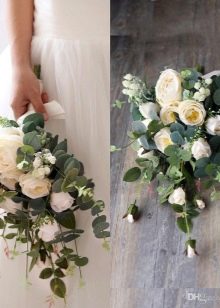
Stylists recommend replacing snow-white roses with beige, peach flowers or moving the composition of tea roses to the center. This is because white roses will be lost in the background of a classic snow-white dress.
If the bride chooses white roses along with ivory or champagne, then the latter will look dull and stale against the background of white petals.
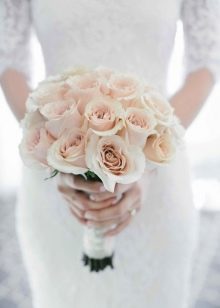
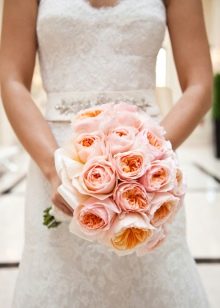
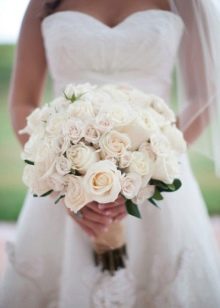
Confident ladies, passionate, enthusiastic natures choose a bouquet of red roses. In the language of flowers, this speaks of a strong feeling, deep affection, passion. Red is an active color, therefore it is advisable to “support” it with accessories of a similar shade - shoes, jewelry.
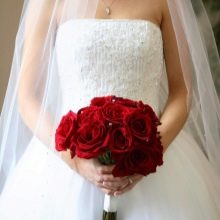
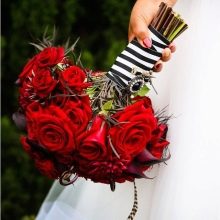

It is allowed to use bridal roses in a wedding bouquet. However, if it will be a mono-bouquet, it will turn out to be too dramatic and even gloomy.
Florists recommend burgundy roses to be diluted with lighter colors or use a lighter decor, for example, beads, gypsophila.

Pink roses are a universal wedding bouquet that fits any bride’s outfit. Traditionally, it sees tenderness, romance, and daydreaming. Pink flowers blend well with all pastel and bright, saturated colors.
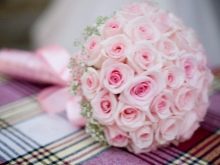
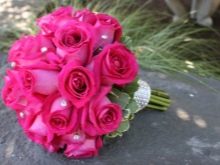
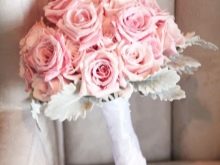
For a long time in our country, yellow roses were considered the messengers of separation and betrayal and, of course, were not used in wedding compositions. However, in fact, these flowers symbolize joy, light, family well-being and financial luck. Undoubtedly, only a bold and original bride can resist prejudice using yellow roses. It is worth noting her easy temper, optimism.
Yellow roses are good in tandem with white, as well as flowers of blue, lilac and violet shades.
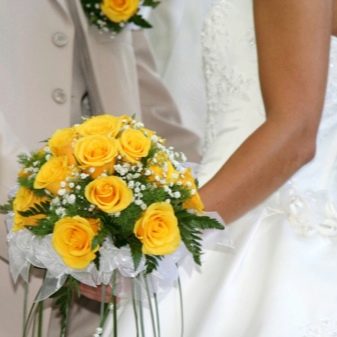
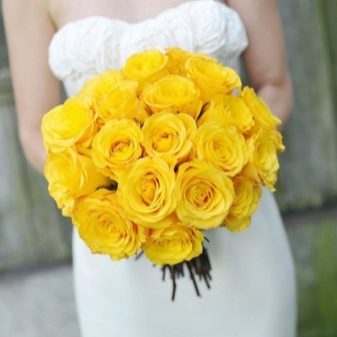
Today, florists also offer brides bouquets of delicate greenish, pistachio tones. They allow you to get original mono-bouquets and go well with snow-white roses.If we talk about the symbolism of green roses, then this is a sign of family, harmony, fertility.
White-skinned brides should choose such bouquets with caution, since the skin can acquire an unhealthy shade from such a “neighborhood” with flowers.
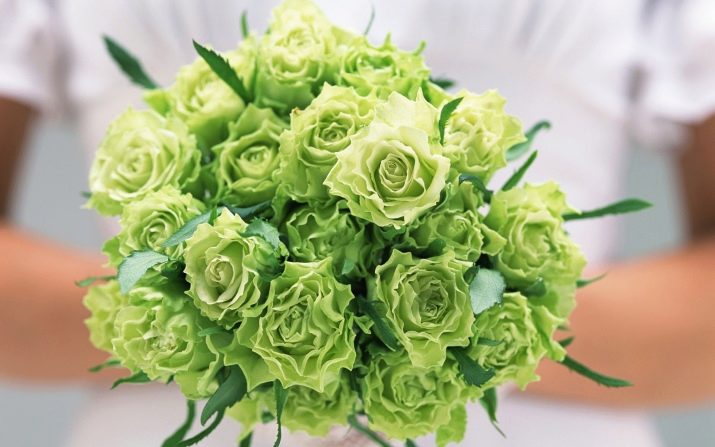
A bouquet of blue roses is commonly used in theme weddings. It looks very unusual and symbolizes mystery, dreaminess. As a rule, blue roses complement with white. A good tandem will come from blue roses diluted with yellow buds.

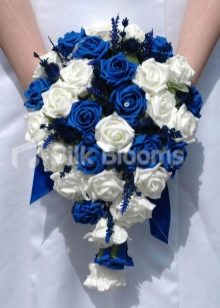
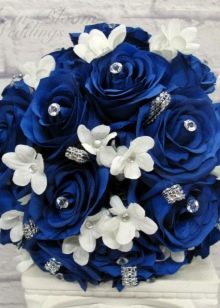
As a rule, large roses are used in classic bouquets, but if you want something unusual, brides choose small bush roses. The latter are good both on their own and as a decor for larger single roses or other flowers.
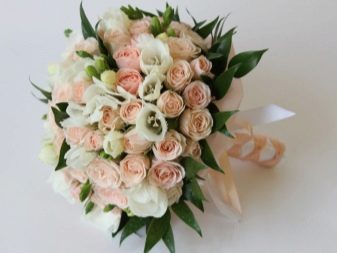
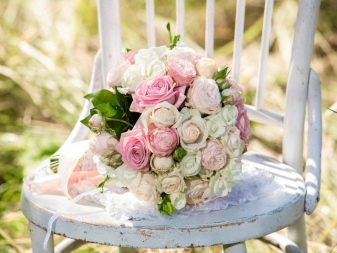
In recent years, the use of peony roses has become one of the trends in wedding floristry. They delight in their splendor and sophistication and are good both in mono-bouquets and in compositions with other colors.
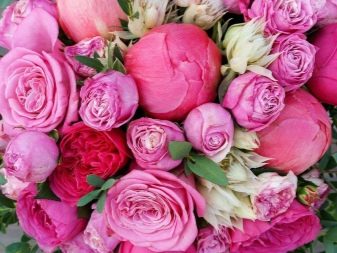
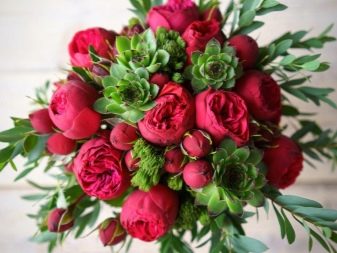
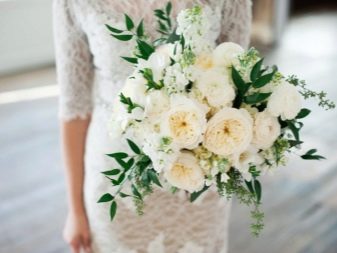
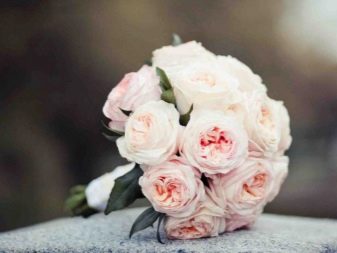
Combination with other colors
Small white or light roses can be combined with hydrangeas, lilies, delphinium. “Companion” can have any shade, but preference should be given to pastel, pink and blue shades, then the composition will turn out to be fresh, airy and very tender.
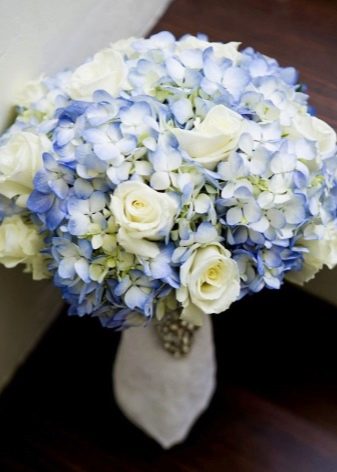
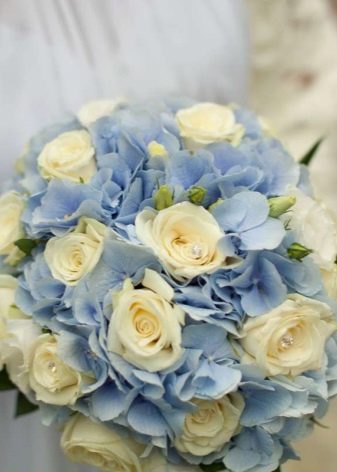
Small inflorescences, as well as bush roses, harmoniously look with daylily, delphinium. Carnations are increasingly found in wedding bouquets. And this is understandable - being modest, they emphasize the luxury of more expensive flowers, being lush - will create texture and additional volumetric composition.
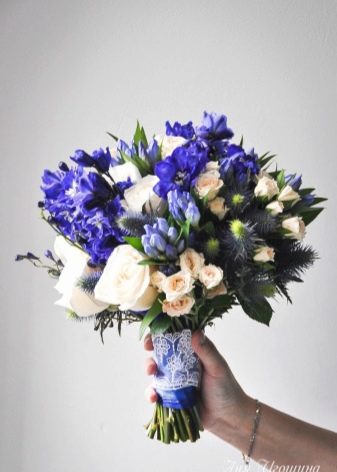
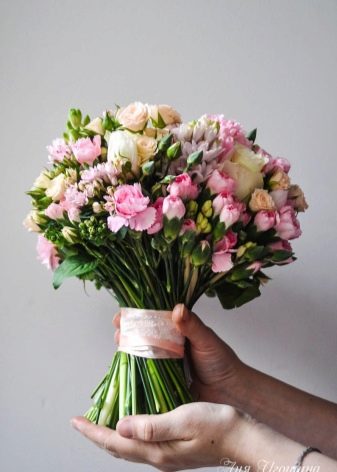
Incredible lightness and tenderness is provided by the combination of small rose inflorescences with alstroemeria, eustoma. Eustoma, by the way, is similar to roses, but has a more fluffy core. They also admire the sophistication and variety of shades, so they go well with all kinds of roses.
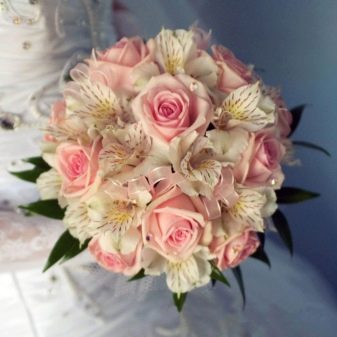
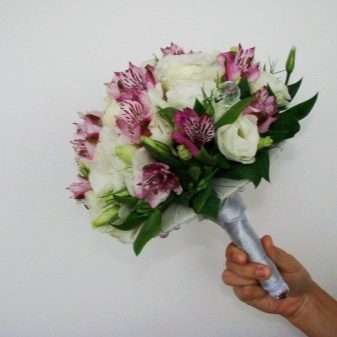
Very versatile red and scarlet roses. They are good with lilies, peonies, as well as modest chrysanthemums, daisies. Good similar tandems from gerberas are a great option for courageous and extraordinary personalities.

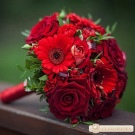
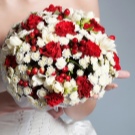
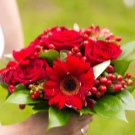
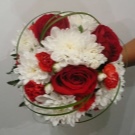
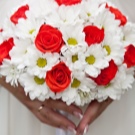
To achieve elegant and stylish combinations allows the use of roses with peonies, lilies, orchids, callas in the composition.
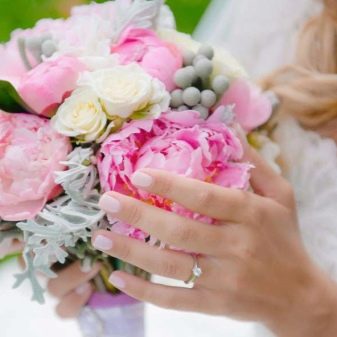
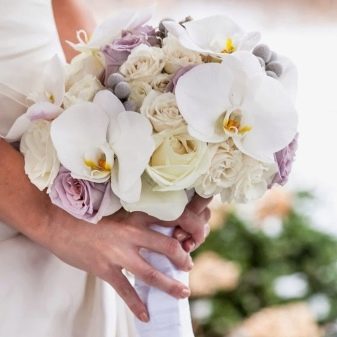
As you can see, roses are combined with a lot of other flowers. However, creating such compositions, one should not forget about the style of the wedding, the image of the bride. So, at a classic celebration, a combination with wildflowers and decor would be inappropriate. As much as an abundance of decor, careful thoughtfulness of forms does not look in a boho-style bouquet.
Decoration and decor
Today, wedding style does not approve of a large number of decor in a bouquet. Moreover, roses are beautiful and self-sufficient, and excessive decoration can ruin their natural charm.
As a decor, you can use a small amount of floral mesh or paper. As the latter, it is better to choose kraft paper of a natural shade, but the use of films and rustling paper, corrugations today is a bad manners.
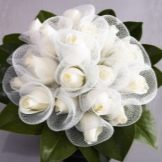
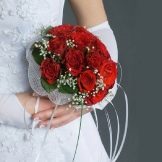
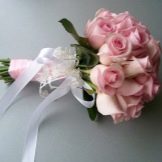
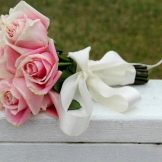
For round and hemispherical bouquets, satin ribbons of various widths and shades are usually used as decor. You can also complement the composition with small beads, a brooch.

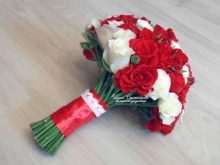
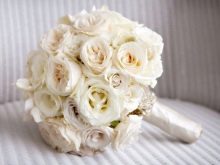
The most popular decoration is greens. It can be leaves of roses, gypsophila, monstera, bergras, fern. The bouquet decorated with chrysanthemums-Santini looks original, which are small fluffy green or yellow “balls”.
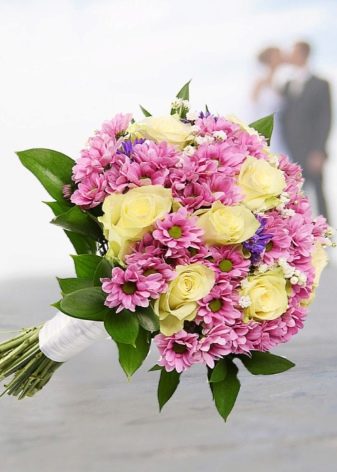
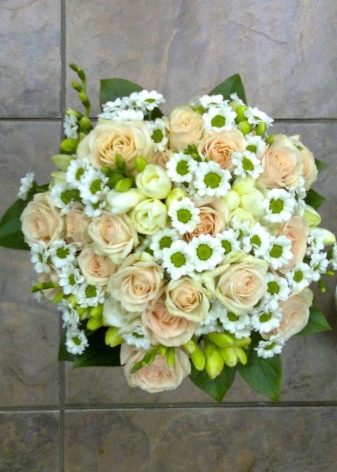
For seasonal bouquets, sprigs of apple or cherry with flowering petals, ears of wheat or rye, small sunflowers can be chosen as decor. Winter bouquets are good with lush cotton bolls, crystallized (as if powdered with hoarfrost) berries or small fruits.
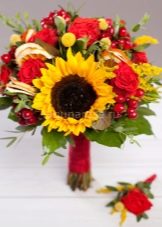
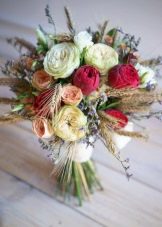
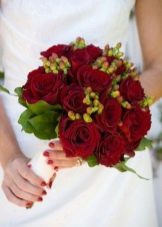
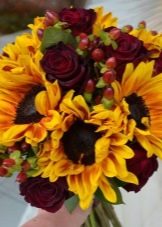
Red and pastel inflorescences go well with brunia. These are small silver-colored balloons that are especially fond of “winter” brides.
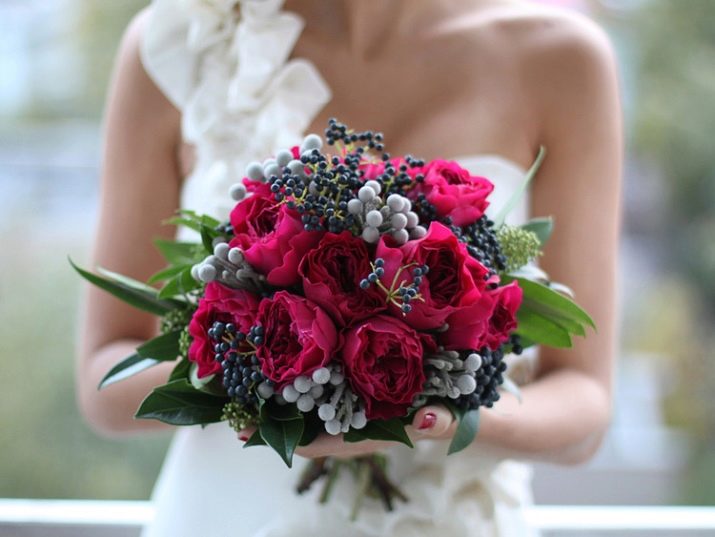
To soften the bright shades of roses and give greater expressiveness to delicate colors, greens of a soft, bluish shade helps. It seems that it is covered with wax. Eucalyptus branches and some succulents do an excellent job of this task.
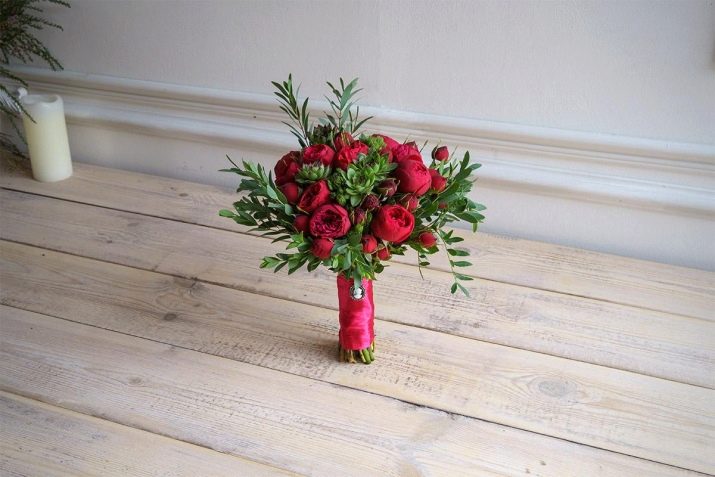
Tips from stylists and florists
For winter weddings, as well as for a very active wedding day, you should choose roses of red, scarlet, burgundy shades. They are more persistent than roses of other colors.
When choosing the shade of the “Queen of Flowers” it is important that he does not repeat the exact color of the dress. Otherwise they will merge. If you choose an outfit and flowers of the same shade, let the latter be 2-3 tones darker.
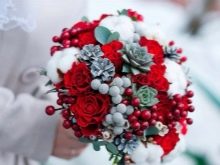
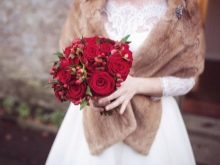
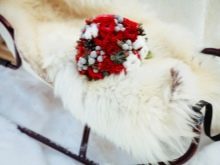
When composing a bouquet, you should decide which flowers in it will be the “main ones”. They are located in the center of the composition, framing smaller ones. Experts do not recommend using more than three different colors in a bouquet. But the shades of the same color can be a great many.
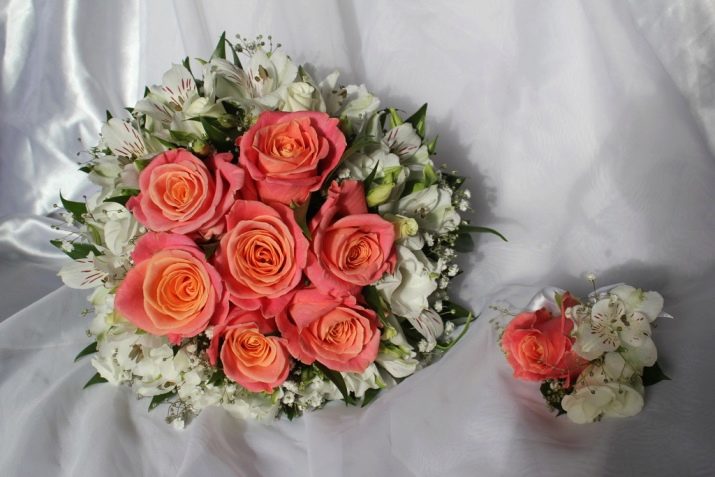
When composing mono-bouquets, flowers should be selected whose shade is at least half a tone different from the other. This will create the volume and texture of the composition.
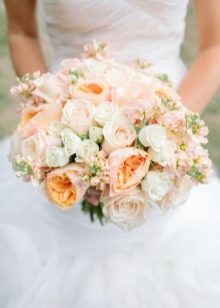
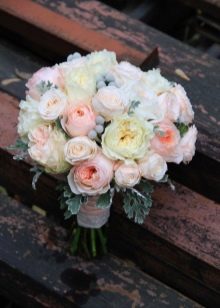

You need to combine the bouquet not only with the dress, but also with the color of the hair. Blondes are recommended to use gentle pastel colors in rose bouquets. Pink, light blue, and lilac roses will also suit them.
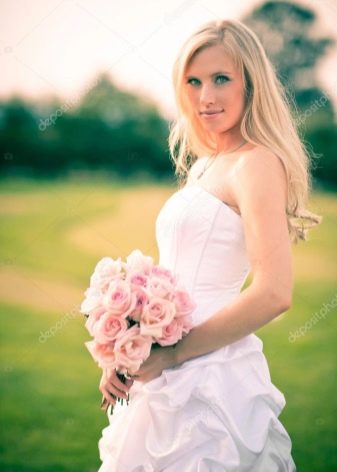
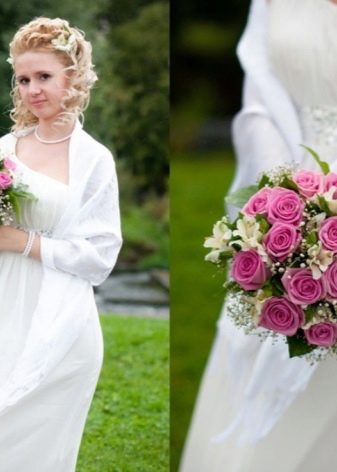
Brunettes can pick up a bouquet of a saturated shade, making sure, however, that their tone is warm. You can combine burgundy velvet roses with white shades or greens of a saturated shade.
For red-haired brides, you can recommend cream, gray, golden and purple roses. Blue-white, pistachio roses compositions harmoniously blend with their hair color.
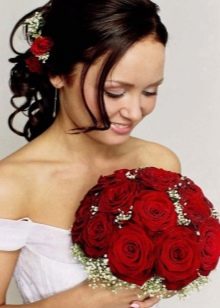


Bouquets of young brides are usually dominated by half-opened roses, inflorescences in the form of a glass (for example, tea-hybrid varieties), buds. It is better for mature women to choose the revealed inflorescences.
Bouquet for the wedding should be collected from fresh, strong flowers. Well, if this is done 2-3 hours before the start of the celebration. You can extend the life of the finished composition by wrapping it in paper and putting it in the refrigerator. The legs of the bouquet, if possible, should first be wrapped with a damp cloth.
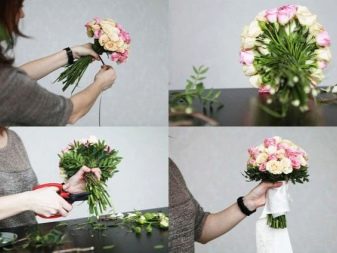
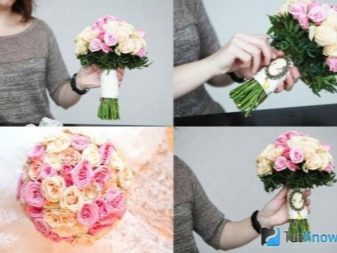
Beautiful examples
A bouquet in the style of minimalism - a combination of snow-white roses and the same shade of orchids. Greens help to avoid monotony and add texture. In this case, eucalyptus and fern are equally suitable. Such a bouquet is tenderness itself.
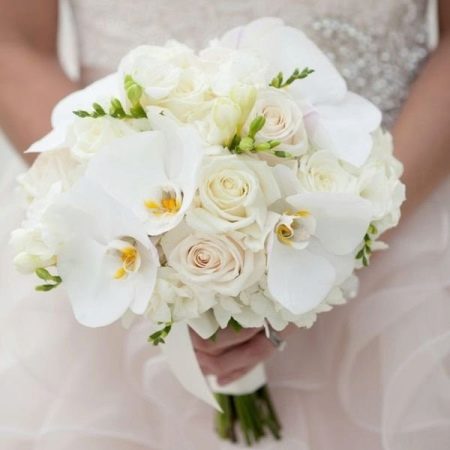
To give splendor to round and spherical compositions, chrysanthemums are ideal. The main thing is to choose those flowers that are slightly smaller than roses or have similar sizes (no more). The color of chrysanthemums can be very close to the shade of tea or white roses or become a bright accent.
The last example is ideal for colored weddings, the color of chrysanthemums is selected in the shade appropriate for the holiday.

An amazing “neighborhood” of delicate snow-white lilies and noble passionate burgundy roses. Both shades benefit from the tandem of contrasts, becoming even more pronounced. The harmony of contrasts can also be seen in the texture of the petals - thin sliding petals of lilies only enhance the velvety of pink petals.
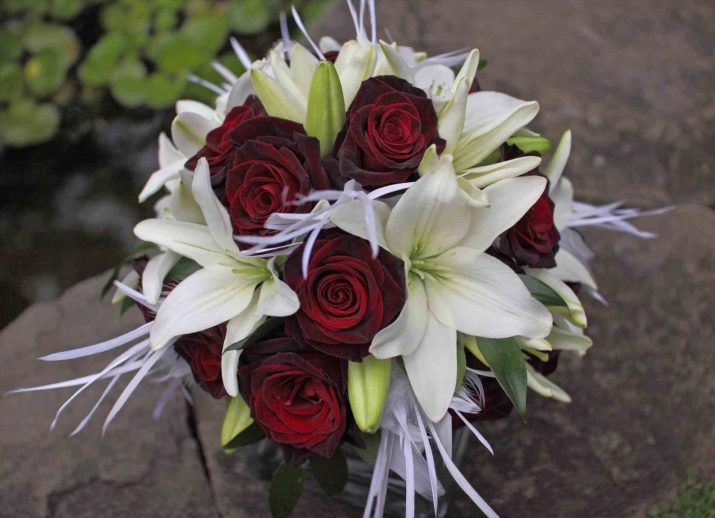
Bright and sunny, and at the same time a very touching and delicate bouquet of yellow and white roses. It is complemented by cheerful Santini chrysanthemums and modest snow-white alstromerias. In this bouquet, by the way, lilac “blotches” - for example, all the same alstromerias, violets or irises, would harmoniously look.
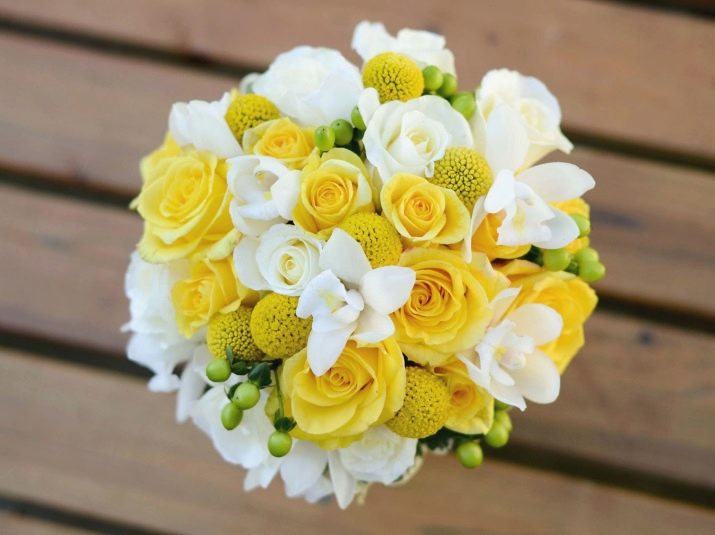
Another variation of a cheerful and juicy bouquet. The basis of the composition is orange and peach roses, the arrangement of which are romantic corollas eustomas. Due to the features of the texture of colors, the composition looks lush, but at the same time airy.
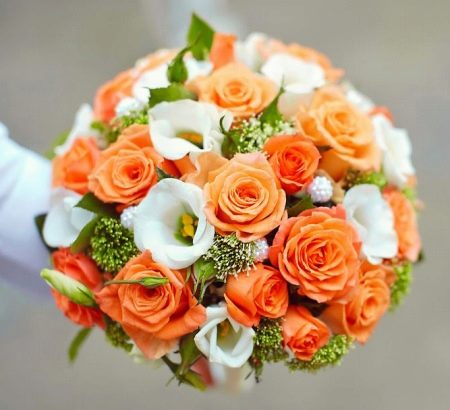
For the airiness and lightness of this composition, no doubt, snow-white freesias are responsible.The dense and folded leaves of the aspidistra become an excellent decor and allow you to save the bouquet from plainness, give it expressiveness.
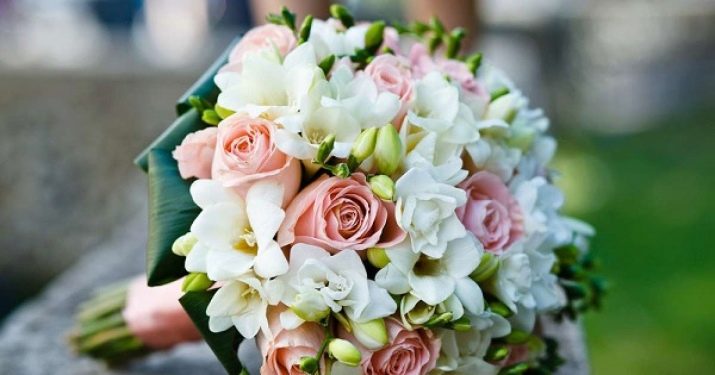
A master class on creating a bouquet of roses with your own hands, see below.
